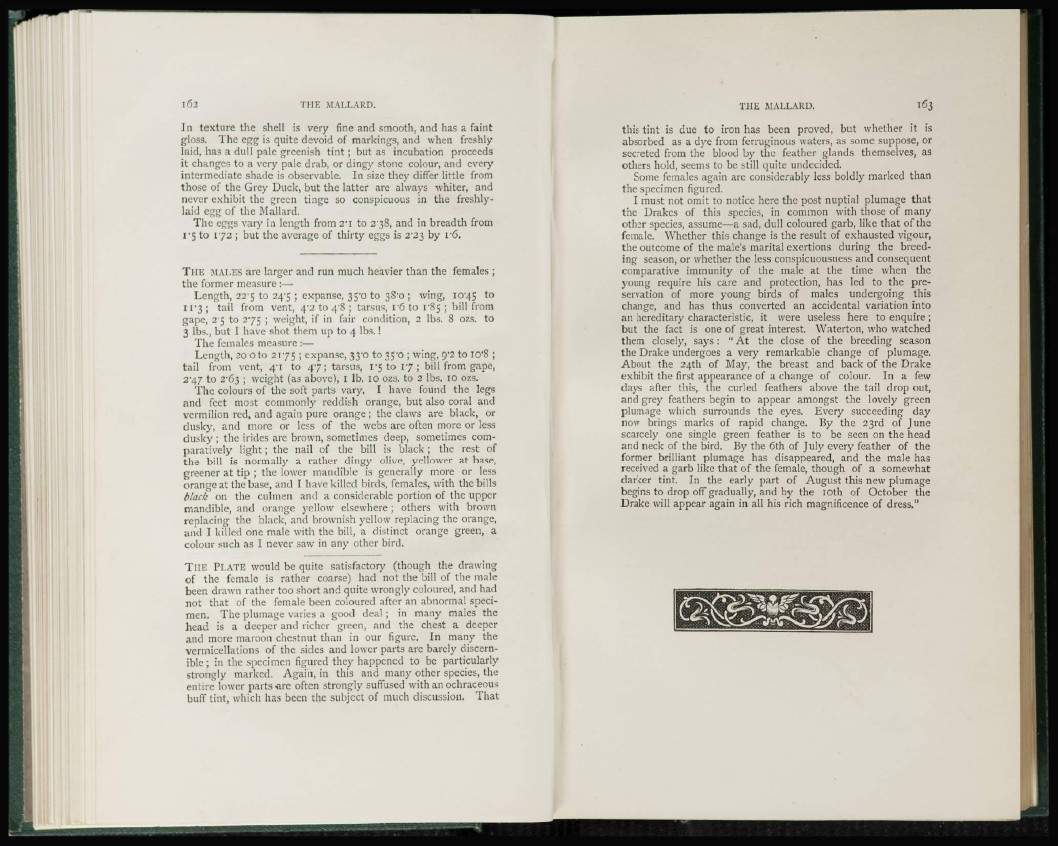
In texture the shell is very fine and smooth, and has a faint
gloss. The egg is quite devoid of markings, and when freshly
laid, has a dull pale greenish tint ; but as incubation proceeds
it changes to a very pale drab, or dingy stone colour, and every
intermediate shade is observable. In size they differ little from
those of the Grey Duck, but the latter are always whiter, and
never exhibit the green tinge so conspicuous in the freshlylaid
egg of the Mallard.
The eggs vary in length from 2T to 238, and in breadth from
l'5 to 1 7 2 ; but the average of thirty eggs is 2^23 by i'6.
THE MALES are larger and run much heavier than the females ;
the former measure :—
Length, 22-5 to 24-5 ; expanse, 35-0 to 38-0 ; wing, 104.5 t o
11 "3 ; tail from vent, 4'2 to 4 8 ; tarsus, 1 6 to 1-85 ; bill from
gape, 2 5 to 2 7 5 ; weight, if in fair condition, 2 lbs. 8 ozs. to
3 lbs., but I have shot them up to 4 lbs.!
The females measure :—
Length, 2 o o t o 2 1 7 5 ; expanse, 33^0 to 35'0 ; wing, Q'2 to I0'8 ;
tail from vent, 41 to 4 7 ; tarsus, 1*5 to 1 7 ; bill from gape,
2 4 7 to 2'63 ; weight (as above), 1 lb. 10 ozs. to 2 lbs. 10 ozs.
The colours of the soft parts vary. I have found the legs
and feet most commonly reddish orange, but also coral and
vermilion red, and again pure orange ; the claws are black, or
dusky, and more or less of the webs are often more or less
dusky ; the irides are brown, sometimes deep, sometimes comparatively
light; the nail of the bill is black ; the rest of
the bill is normally a rather dingy olive, yellower at base,
greener at tip ; the lower mandible is generally more or less
orange at the base, and I have killed birds, females, with the bills
black on the culmen and a considerable portion of the upper
mandible, and orange yellow elsewhere ; others with brown
replacing the black, and brownish yellow replacing the orange,
and I killed one male with the bill, a distinct orange green, a
colour such as I never saw in any other bird.
THE PLATE would be quite satisfactory (though the drawing
of the female is rather coarse) had not the bill of the male
been drawn rather too short and quite wrongly coloured, and had
not that of the female been coloured after an abnormal specimen.
The plumage varies a good deal ; in many males the
head is a deeper and richer green, and the chest a deeper
and more maroon chestnut than in our figure. In many the
vermicellations of the sides and lower parts are barely discernible
; in the specimen figured they happened to be particularly
strongly marked. Again, in this and many other species, the
entire lower parts -are often strongly suffused with an ochraceous
buff tint, which has been the subject of much discussion. That
this tint is due to iron has been proved, but whether it is
absorbed as a dye from ferruginous waters, as some suppose, or
secreted from the blood by the feather glands themselves, as
others hold, seems to be still quite undecided.
Some females again are considerably less boldly marked than
the specimen figured.
I must not omit to notice here the post nuptial plumage that
the Drakes of this species, in common with those of many
other species, assume—a sad, dull coloured garb, like that of the
female. Whether this change is the result of exhausted vigour,
the outcome of the male's marital exertions during the breeding
season, or whether the less conspicuousness and consequent
comparative immunity of the male at the time when the
young require his care and protection, has led to the preservation
of more young birds of males undergoing this
change, and has thus converted an accidental variation into
an hereditary characteristic, it were useless here to enquire ;
but the fact is one of great interest. Waterton, who watched
them closely, says: " At the close of the breeding season
the Drake undergoes a very remarkable change of plumage.
About the 24th of May, the breast and back of the Drake
exhibit the first appearance of a change of colour. In a few
days after this, the curled feathers above the tail drop out,
and grey feathers begin to appear amongst the lovely green
plumage which surrounds the eyes. Every succeeding day
now brings marks of rapid change. By the 23rd of June
scarcely one single green feather is to be seen on the head
and neck of the bird. By the 6th of July every feather of the
former brilliant plumage has disappeared, and the male has
received a garb like that of the female, though of a somewhat
darker tint. In the early part of August this new plumage
begins to drop off gradually, and by the 10th of October the
Drake will appear again in all his rich magnificence of dress."